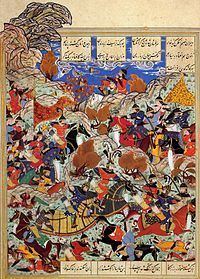Unknown Unknown Date 1400 | Unknown all killed Result Decisive Timurid victory | |
 | ||
Similar Tokhtamysh–Timur war, Battle of Ankara, Siege of Baghdad | ||
Background
Timur was one of the most powerful Central Asian rulers since Genghis Khan. By long and relentless fighting, he sought to rebuild the Mongol Empire of his predecessors.
Contents
Before the end of 1399, Timur started a war with the Mamluk sultan of Egypt Nasir-ad-Din Faraj and invaded Mamluk Syria. Timur's forces took Aleppo He massacred many of the inhabitants, ordering the building of a tower of 20,000 skulls outside the city. After taking Aleppo, Timur continued his advance and besieged Damascus.
Battle
An army led by the Mamluk Sultan Nasir-ad-Din Faraj was defeated by Timur outside Damascus leaving the city at the mercy of the Mongol besiegers. With his army defeated, the Mamluk sultan dispatched a deputation from Cairo, including Ibn Khaldun, who negotiated with him, but after their withdrawal he put the city to sack. The Umayyad Mosque was burnt and men and women taken into slavery. A huge number of the city's artisans were taken to Timur's capital at Samarkand. These were the luckier citizens: many were slaughtered and their heads piled up in a field outside the north-east corner of the walls, where a city square still bears the name burj al-ru'us, originally the tower of heads.
Aftermath
After the capture of Damascus, Timur's Neo Mongol empire now bordered another emerging power in the region, the Ottoman Empire. The two powers soon came into direct conflict. Bayezid demanded tribute from one of the Anatolian Beyliks who had pledged loyalty to Timur and threatened to invade. Timur interpreted this action as an insult to himself and in 1400 sacked the Ottoman city of Sebaste (modern Sivas). Timur would later go on to defeat the Ottoman Sultan Bayezid at the Battle of Ankara.
